Shawcraft Dalek This Dalek is made from various original screen used components of 1960’s Shawcraft Daleks, it became known as “The Wilkie Dalek” due to it being once owned by former BBC sfx designer Bernard Wilkie The dome is a screen used TV style shawcraft and is in very good condition including the interiors fittings for the lights etc. The neck has been restored by former sfx designer Mike Tucker only the rings are original.  |
 |
|
The shoulders are Shawcraft movie style and have the very distinct “sagging” lower
collar which can be screen matched to many 1960’s stories. |
||
Sylvester McCoy’s Umbrella First seen in the season 24 story “Dragonfire” the question mark umbrella soon became a trade mark of the 7th Dr. This Umbrellas were made by renowned London maker T.Fox &Co, the handles were made from a very tough resin painted red this quite often used to chip off on set making the props look rather scruffy towards the end of season 25 hence this prop being made for season 26. 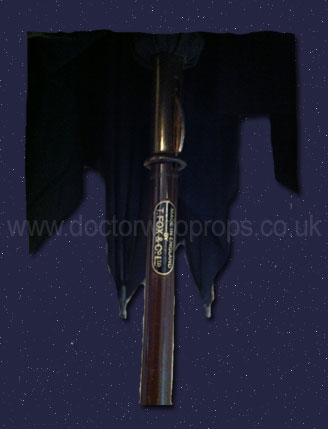 |
 |
|
Miniature TARDIS This prop was made for the season 18 finale "Logopolis", it is a third scale model and is constructed mainly from fibreglass for the side panels and roof with plywood for the base. After the series finished the prop was used one last time in the children's series "search out science" it's was for this program that the prop was modified having the doors cut out and hinged.  |

 |
|
Pistol from Nightmare of Eden This gun was custom made for the Tom Baker story “Nightmare of Eden”, it is constructed from resin and uses palm grips from cricket gloves on the handle. It is one of the better designs of weapon used on the show. . |
 |
|
Dalek This Dalek prop known as the “Tussauds Dalek” due to it being on display at Maddame tussauds in the early 1980’s is one of the finest surviving examples due to a large majority of its components being used in the first story “the Daleks” in 1963 and being used in most Dalek story’s up to its last appearance in “Revelation of the Daleks” in 1985. The colour of the Dalek is “Porsche Riviera blue” it was first painted this colour for its display at Madame Tussauds before being painted back to Grey for its appearance in “Revelation of the Daleks” When the prop was restored in 2004 it was once again painted “Porsche Riviera blue”. This colour is unique to this Dalek and never feature in the series painted this way. From what we can see the Dome is an original 1960’s including most of the internal mechanisms the eye stalk is a replacement, the neck bin is also an original 1960’s and is in very good condition the outer posts and rings were replaced in the 1980’s. The shoulder section is an original 1960’s shawcraft with replacement slats and possible replacement gun and plunger arm. The most interesting section of the Dalek is the skirt as it is angled at the back as well as the front, this was made sometime during the 1970’s and first appears on screen in “Genesis of the Daleks”, the hemispheres were replaced when the Dalek was restored, the base is also original. The history of the Dalek is well documented first being sold in aid of charity in the 1980’s and then being restored for its sale at Bonham’s in 2005, it was bought by the company Indprod who displayed it in their foyer before going bankrupt in the early part of 2009, it was then sold at auction and is now owned by a private individual. Doctorwhoprops.com was fortunate enough to photograph this prop prior to it being auctioned in the early part of 2009. |
  |
|
Thordon CD Phaser This intricately made prop is one of four made by Paul McGuiness for the "Trial of a Timelord" story "Mindwarp" this is the hero light up version that is used by the Doctor inside the cave. It is made from fibreglass and clear Perspex with internal electrics to operate the light up end piece. |

|
|
Sontaran Communicator This Sontaran Communicator was made for the Tom Baker story “Invasion of Time”, it is constructed from wood, plasticard and Perspex it was very likely made by either Ian Scoones or Mat Irvin, on the back of the prop is an aluminium hook for attachment to the costume. It is the oldest known surviving example of a Sontaran Communicator. |

|
|
Vegence on Varos Gun This Gun was made by Martin Bower and was used in the Colin Baker story “Vengance on Varos” the base of the gun is made from garden hose parts with added resin and aluminium pieces to give the effect of an alien weapon!! This is a classic example how everyday objects were converted to produce very effective props. |
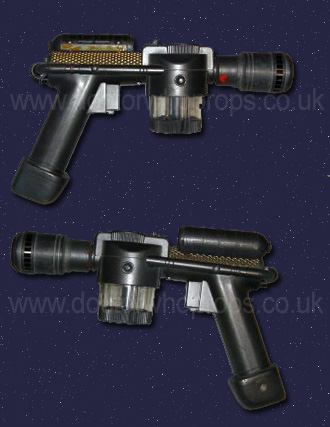
|
|
Dalek eye stalk This eye stalk was used in the 1988 Sylvester McCoy story “Remembrance of the Daleks”, over the years the eye stalk remained largely unchanged being constructed from various parts including separate rod , eye ball and rings, for this story the visual effects team modernised the design and moulded the eye stalk in one piece from fibreglass over a wooden centre rod. Original screen used Dalek items are incredibly rare and this is one of the only know surviving examples of an original eye stalk, it has been cut down the centre to be used as a display piece at an exhibition in the early 90’s. |

|
|
Dalek Gun 1973-1979 Original Dalek items are extremely rare it is a common misconception that there were many Daleks made for the various story’s that they appeared in but in truth only four were made for the first story in 1963 with some of the movie style daleks being converted in the late 60’s and a further 5 “Goon” Daleks being built as background props for “planet of the Daleks” this was pretty much it until the 80’s when some moulded fibreglass examples were made. So in total around a dozen Daleks were used over the 26 year run of the original series, now many of these were damaged blown up etc... and many were destroyed, so it is very difficult to estimate what still survives and it is almost certain that very little still survives in its original state from the early days of the program as the Daleks were modified and repaired from story to story. This Gun was originally made for one of the “goon” Daleks used in “Planet of the Daleks” it then appeard in all remaining story’s until “Destiny of the Daleks” it is made from an aluminium tube with copper rods attatched and a wooden ball at one end that was fixed to the Dalek shoulder section. |

It was originally sold at the Doctor who celebration day held at Longleat in 1983 it was one of two Dalek guns sold which were lots 35 and 36 it sold for £82! Even back then this was expensive compared to other items in the auction which averaged £20-£30 showing just how desirable Dalek items are. The whereabouts of the other gun are unknown making this gun possibly the only remaining example in existence that can be guaranteed 100% screen used and authentic. |
|
TARDIS Key This TARDIS Key was made for Jon Pertwee's last season and first featured in the 1973 story "The Time Warrior". It is belived that it was Pertwee's idea to have a specilly designed TARDIS Key insetad of the Yale Key that had been used from Hartnell onwards. The Key is hand made from a High copper content metal, the main body of the Key is two parts sandwiched together and all of the "triangle" shapes on the front have been braised on, to prove its authenticity i have screen matched over 15 points on the Key to the scene from "Planet Of The Spiders" were Sarah takes the Key from the Doctors pocket, this type of resurch is crucial with an item as significant as this. The TARDIS key is one of the most iconic items used in Doctor Who so much so that it has been copied many times over the years, what makes this TARDIS key so important is that it is the one that started the craze! The Key used by Tom Baker in his first two seasons is different to this Key and does not have as much detail. This Key was last seen on screen in "Planet Of The Spiders", after filming Jon Pertwee kept the key as a momento of the show. He sold it to a collector in America in the early 90's along with the "Planet Of The Daleks" jacket that can be seen on this site under costumes. This key is now owned by doctorwhoprops.com |
 |
|
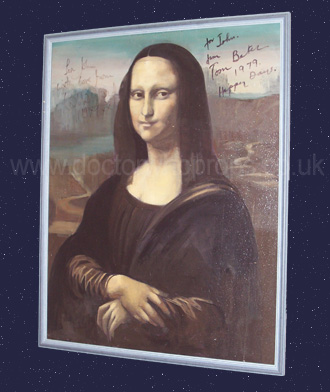 |
Mona Lisa painting This is one of six Mona Lisa paintings that was made for the 1979 story "the City of Death". What is remarkable is that each one of the six was hand painted by a BBC scenic artist and all are slightly different if you look carefully!  They are quite crude when close up but very effective under the dim studio lights
It is painted using acrilics on vestoply board, on the back is the story title and date, the artists name is not present.
This one was given to a props man working on the story and is signed by both Tom Baker and Lalla Ward.
|
|
Minature Tardis Prop This models was made by visual effects designer Mat Irvine for the 1975 story the 'Pyramids Of Mars'. Mat Irvines first work on Doctor Who as an assistant to Ian Scoones was to fit the flashing light to an early model of the Tardis using the mechanism from a metronome. The model is constructed from plywood for the corner posts, base, 'police public call box signs' and parts of the internal structure, all four side panels are made from plastic card and card board has been used to give the eight panels on each side depth, the roof is also made of plywood and plastic card. Inside the model as outlined by the red and green arrows are four small holes and one large hole, thease were most probably for suspending the model from fishing wire or attaching it to a spinning rig. |

 |
|
 |
This model was first used in the Tom Baker story 'Pyramids Of Mars' and finally seen in the Peter Davison story 'Time Flight'. Between these years it was used in many classic Doctor Who story's most notably the famous 'in space' shot seen through most of the Tom Baker era. This model was on display at longleat until 1983, it now belongs to a private collector in the USA. |
|
The Key to Time Visual Effects designer Dave Havard constructed the six segments of the key in wood. These were then moulded in silicon rubber. Two castings were then made of each segment in clear casting resin. Due to the extreme heat generated by the catalyst for the resin each segment was cast in a number of layers. When held up to the light these layers are visible in each of the segments. Two complete keys were made. One for the individual segments, the other was used for the flying sequence in Episode one where the complete key was required. This prop is the flying version. The core of the prop consists of a plastic rod. This has a hole drilled through it. Over time the prop became heavily stained with cigarette smoke and the tape joining the sections began to break down. The segments have had a light clean and the old tape has been removed. After the production the prop was retained by Producer John Nathan-Turner in his office at the BBC. When the show was cancelled John took this item home. |
 |
|
Doctor's Stellar Signal Receiver "PYRAMIDS OF MARS" This is the only one of this prop that was made for the classic 1975 story "Pyramids of Mars", it is used by the Doctor in episode one when he uses it to decipher the message "beware sutek". It was made by one of the most famous BBC visual effects designers of the time Ian Scoones, and is entirely scratch built of plastic and some aluminum and has a toggle switch at one end and a circular orange piece at the other although this does not function as this was always intended as a static prop. |
 |
|
 |
On the side there is a panel of numbers from 1-9 with a small red marker that moves up and down using the arcamedes screw principal, also attached is a conventional radio aerial. This prop was kept after filming by Ian Scoones and later used in the Blake’s 7 episode "Project Avalon”. |
|
This piece is special as it’s from one of the most popular and well loved story's from Doctor Who's history, the fact that so many of the props and costumes from this period were either lost or destroyed makes this piece very rare.
|
 |
|
Time Lord Secrets This prop was constructed from an AGFA film case from the BBC film library. Early in the series they appear to be silver but in the last two episodes The Master is seen using this gold version. |
 |
|
 |
TARDIS key Constructed by visual effects assistant Mike Tucker during filming of ‘The Greatest Show in the Galaxy’ this prop was finally seen on screen in ‘Ghostlight’ and in the last ever classic series story 'Survival'.
The prop was constructed in plastic board, moulded in silicon and finally cast in resin. The symbol in the middle is the Pydonian seal that was first seen in the Tom Baker story The Deadly Assassin. This was the first time that the Time Lords home world of Gallifrey was seen.
The prop was kept after filming by the series Producer, John Nathan-Turner.
|
|
The Doctor’s Magnifying Eye Glass This property was kept in the Doctor Who production office amongst ‘The Doctor’s hand props’. It appeared in numerous stories during the Pertwee and Baker eras. Colony in Space, Genesis of the Daleks, Terror of the Zygons |
 |
|
Skaroth last of the Jageroth This mask was designed by make-up designer Jean Steward for actor Julian Glover. Two versions of the mask were made using a technique pioneered by John Friedlander. John did not make the mask as has been reported in numerous books. The core of the head is muslin and the ‘worm’s were made with latex mixed with a silicon powder. The mixture was simply piped over the core. The eye is a hand painted half ball.
City of Death (1979)
|
 |
|
 |
The Fly This prop was constructed by Colin Mapson under the direction of designer Ron Oates. The Green Death (1974) |
|
Master’s Tissue Compression Eliminator this prop was constructed from heavy black painted brass with electrical wiring attached for lighting up the bulb when the blades open at the front, it is used by anthony ainley as the master, this particular prop was used for close up scenes. |
 |
|
 |
Five Doctors Figures Many people who were fans of Doctor Who eventually came to work on the series. Sue Moore constructed numerous models for the fan market but was eventually commissioned to create these figures for ‘The Five Doctors’. |
|
Sixth Dr's tracer from "Mark of the Rani" There were two of these props made for the 1985 story "Mark of the Rani" this is the working hero version, it was used throughout the first episode by the Doctor. the other version was only used in the scene were the tracer is kicked out of the Dr's hand and down the well. |
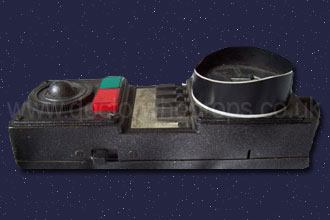 |
|
 |
It is made from a converted ideal toys walkie talkie with switches and bits added to it,at one end there is an arrow cut into the plastic and covered with green cellophane that lights up and flashes when the button on the side is activated, there is also a small tap switch underneath that can be turned to speed up or slow down the flash . it was kept by producer john nathan turner after filming and later sold at longleat 1997. |
|
Master door opening device from "Mark of the Rani" There was only one of these made for the 1985 story "Mark of the Rani". This prop is only glimpsed briefly when the master uses it to open the door to the Rani's lair. It is constructed of black and red perspex for the base on top of which sit three square metal plates with a switch on top to activate the bulb in the centre which makes the red perspex sections of the cube glow red. |
 |
|
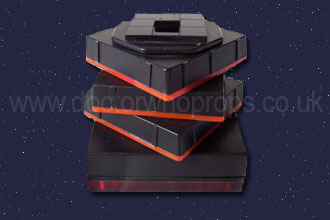 |
Not seen on screen is the fact that all three plates revolve. It was kept by producer John Nathan turner after filming an later sold in the charity auction of panopticon 1990 after which it has past through various collectors hands. |
|
The Doctors calling card from "Remembrance of the Daleks" this is the only calling card that was made for the 1988 story "remembrance of the daleks" it is left by the dr at radcliffes head quarters, it is made from card with a magnetic strip running diagonally from one end to another, the seal is made from resin with a brass question mark attached to it, on the top and bottom is gallifreyan writing. although only on screen for a short period of time this is one of the seventh dr's most memorable hand props, so much so that dapol were going to market it as a toy, a prototype was made by the company but never made it into production. after filming the card was on the wall of the dr who production office of john nathan turner after the show was axed he kept it in his personal collection. |
 |
|
 |
Privateer Crew Pistol: Warriors Gate These guns were designed by one of the shows most famous visual effects assistants Mat Irvine. They were intended to be made from cold-cast resin which is resin mixed with metal powder to produce a substance which looks like metal. It is very strong but also light, unfortunatly communications with the prop builder got mixed up and the guns came back in solid steel, these were to heavy to be carried in the holsters so Light Vac formed plastic versions were made for this purpose and the solid steel ones were used for close up shots. In one scene crewman Packard played by actor Kenneth Cope hits the side of the TARDIS with one of the steel guns and you can see the TARDIS prop visibly rock. After use in doctor who the steel versions were painted silver for use in Blake's 7, this gun has now been repainted with the help of Mat Irvine back to its original colour as seen in the classic Tom Baker story Warriors Gate. |
|
Alpha Centaurai Apart from the head this arm is probably the only surviving piece of the Alpha Centauri that still exists! like many other items from the early era of Doctor Who it was rescued from a skip by a passer by, it was common practice for the BBC to throw away items they no longer required, due to this fact props and costumes from this era are incredibly rare. |
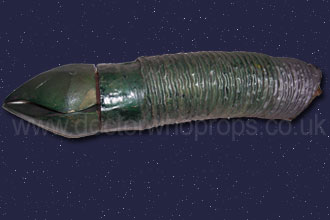 |
|
 |
The Claw is cast from fiber glass and hinged to flexible piping that has been spray painted green, to hide the actors hand the inner section of the claw is lined with brown felt. Although only a small part of this iconic Doctor Who creature it is an important find brought to you to enjoy by doctorwhoprops.com. It was used in two Jon Pertwee story's Curse of Peladon 1972 & Monster of Peladon 1974 |
|
 |
Seventh Doctors Spoons These spoons were made for the 1987 story “The Time And The Rani”, which featured the first appearance of Sylvester McCoy as the Seventh Doctor. They were part of a machine in the Rani’s lair and were one of three sets. The Seventh Doctor takes them out of the machine and starts playing them, after this story they became one of his trade marks and are played on numerous occasions in later story’s. They are basic flat were spoons that have been cut to give them an unusual look and then finished off being sprayed green with a red line down the back. All three sets were kept by Producer John Nathan Turner after filming this is one of those sets. |
|
Kane’s Coin For the season 24 story “Dragonfire” the character Kane test people by placing a coin in their hand which then frezzes to their skin leaving a scar!! BBC visual effects made one resin coin for close up shots and a few vac formed coins that contained the “Smoking liquid” to create the effect of the coin being ice cold, this is one of the vac formed coins. |

|
|








